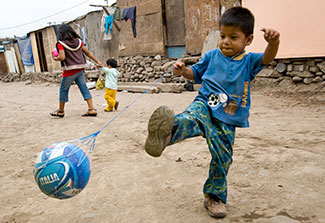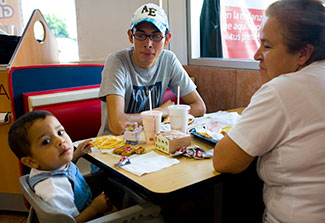Focus: Preventing childhood obesity in Latin America
September / October 2017 | Volume 16, Issue 5

Photo by David Snyder for Fogarty
A new Fogarty-organized publication provides a research
agenda that includes study of interventions to increase
children's physical activity, especially in urban areas, to
reduce the obesity epidemic in Latin America.
By Shana Potash
Grappling with childhood obesity rates that are among the highest in the world, Latin America is experimenting with a number of innovative prevention strategies. To better understand the causes of the epidemic and the most effective ways to address them, a new publication organized by Fogarty staff offers a research agenda for the region, examines recent programs and policies, and identifies areas where research capacity could be improved.
Preventing Childhood Obesity in Latin America: An Agenda for Regional Research and Strategic Partnerships, a special issue of the journal
Obesity Reviews, is the result of a workshop hosted by Fogarty's
Center for Global Health Studies. The meeting brought together U.S. and Latin American scientists, policymakers and implementers and laid the foundation for the five-article supplement authored by Fogarty staff along with researchers in the U.S., Argentina, Chile, Guatemala, Mexico and Peru.
"This is a problem that has to do with behaviors, and you really need to look at the factors in the environment and the individual that influence those behaviors," explains Dr. Juan A. Rivera, General Director of Mexico's Institute of Public Health, who co-chaired the meeting and co-edited the supplement. "It's a complex issue," he says. "There is no silver bullet in the fight against obesity."
For the best chance of success, interventions should be evidence-based and developed and implemented with support from multiple disciplines and sectors - from academia to industry and grassroots to government, the authors suggest. And, to have the greatest impact - and head off comorbidities such as cardiovascular disease and diabetes - prevention efforts must start at an early age.
"Obesity is kind of a wave that is catching younger children who are adopting different lifestyles and eating patterns," says Dr. Benjamin Caballero, professor emeritus with Johns Hopkins Bloomberg School of Public Health, who also co-chaired the meeting and co-edited the supplement. "A child who reaches puberty being obese can have a big risk of continuing to be obese as an adult, and this type of obesity is very difficult to overcome."
Examining the drivers of obesity
Currently, more than 20 percent of the region's children younger than 20 years old are overweight or obese and those rates are expected to rise if no action is taken. Improved socioeconomic conditions, rapid urbanization and a proliferation of supermarkets and fast food outlets are among the factors researchers have identified as contributors to unhealthy diets, sedentary behaviors and childhood obesity.

Photo by David Rochkind for Fogarty
The rise in fast food consumption is one reason more than
20 percent of Latin American children are overweight or
obese, researchers report.
A nutrition transition toward foods that are energy-dense and nutrient-poor is evident throughout the region, the supplement reports. Since 1998, sales of snacks, sugar-sweetened beverages and frozen, ready-to-heat foods have climbed in many countries. An increasing share of the retail sector is occupied by supermarkets, which sell more packaged and processed goods than traditional open-air markets. And, fast food chains have grown exponentially - McDonald's, for example, surged from 100 outlets in 1995, to more than 2,200 in 2014.
This increased availability of calorie-laden foods is occurring in what is the most inactive and urbanized region in the world, the scientists say. Almost 80 percent of people in Latin America live in metropolitan areas where crime, traffic and limited open space can lead to physical inactivity.
A research agenda to prevent obesity
Adding to the complexity of the obesity epidemic is the problem of undernutrition which, while improving, is still prevalent in some areas, creating a dual burden of disease and the need for interventions addressing both ends of the nutrition spectrum.
While the region has its challenges, it also has its strengths.
"We have a bit of a sweet spot in Latin America," says Dr. Michael Pratt, a professor with the University of California, San Diego School of Medicine who was a workshop participant and an author on two articles. "There's a political will and interest in taking these issues on that's spurring very innovative approaches," he says. Additionally, there are some strong research and training institutions providing a base on which to build.
It is against this backdrop that supplement authors propose a research agenda focusing on five areas.
To understand the relationship between undernutrition and obesity, the authors say "biological challenges across the life cycle" should be examined. Can a mother's physical activity during pregnancy, early feeding and activity patterns, and ethnicity or indigenous ancestry play a role in obesity?
Another line of inquiry would explore direct and indirect drivers of dietary and activity patterns. How does the availability and price of food, or the marketing of products, impact choices? Are government efforts, such as dietary guidelines and package labeling policies, effective?
Noting a need for more data, research to improve surveillance and measurement is among the priorities. Recommendations include incorporating routine monitoring of physical activity and nutrition into national health surveys and examining how transportation systems, for example, impact activity.
Evaluation of programs that encourage people to make lifestyle changes is another suggested focus and includes leveraging technology to encourage children and teens to exercise and eat a healthy diet.
Recognizing Latin America's leadership in adopting innovative policies, the agenda calls for research to assess their implementation and to determine how an effective intervention can be adapted elsewhere.
Translating research into policy and practice
Mexico's tax on sugar-sweetened beverages, package labeling requirements in Chile and Ecuador, and Argentina's regulation of trans fatty acids are examples of policies based on scientific evidence. There's also research to support
Ciclovía recreativas or "open streets" programs, which temporarily close roads to vehicular traffic to transform them into recreational areas for cycling and other activities. The idea, which began in Colombia, has spread to nearly 500 cities in Latin America as well as countries outside the region, including the U.S.
These interventions are highlighted in the supplement as case studies of how research was successfully - although not always easily - translated into practice. Collaborations among scientists, policymakers and advocates were key to communicating research findings to different audiences, overcoming potential barriers and directing investigators to policy-related questions. Implementation science, the authors note, can contribute to the successful deployment of policies.
There is room for growth in the research capacity needed to generate evidence for prevention initiatives, according to an analysis of published articles reported in the supplement. Obesity was the most-covered research topic, appearing in about half of the articles, signaling a need to invest in capacity to address nutrition, physical activity and other obesity-related issues. Few articles reflected partnerships or collaborations among scientists from different countries, which the supplement authors say would strengthen institutions and harness complementary expertise, as exemplified by HIV research in Africa. In addition, there were very few intervention studies and policy research papers published, which suggests a void in capacity related to that type of work. Further efforts have the potential for great impact globally, the authors agree.
"Improving research and capacity in Latin America might really pay off not just for the region, but around the world because there are some fascinating things going on," says Pratt. "If they are well evaluated, they can guide policies not just in the region, but with a certain amount of adaptation, potentially in many other countries."
More Information
To view Adobe PDF files,
download current, free accessible plug-ins from Adobe's website.